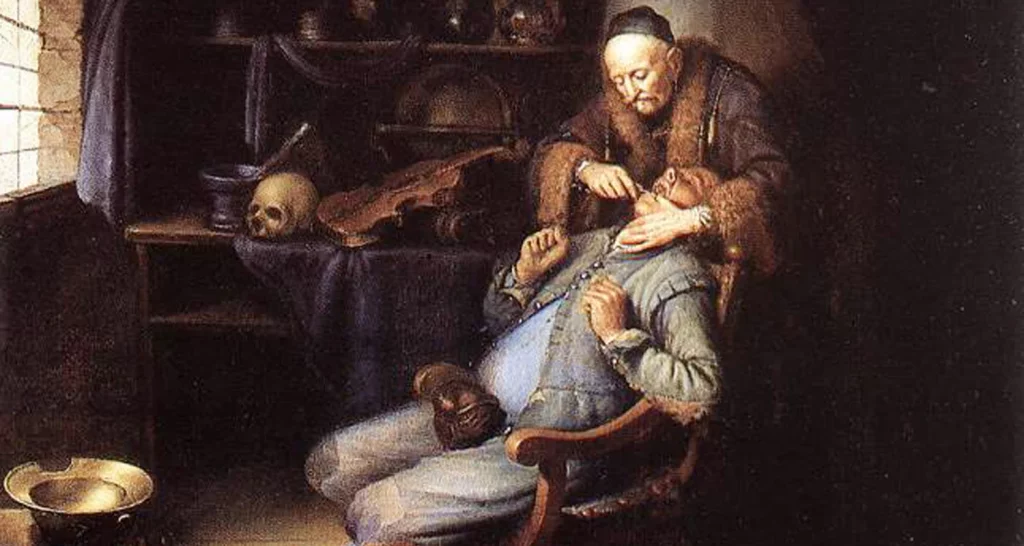Last Updated on: 3rd July 2025, 08:07 am
During the American Revolution, dental health was very poor. People had little knowledge of oral hygiene, suffered from tooth decay and gum disease, and treatments were painful and done by untrained barbers.
In the 1700s, there were no dentists like we have today. Barbers or tooth pullers, with no medical training, treated teeth by simply pulling them out without anesthesia, causing extreme pain.
People didn’t know they should clean their teeth daily, so cavities, gum disease, and tooth loss were very common. It wasn’t until the 19th century that dentistry started to improve.
In this article, we’ll look back at history to understand what dental care was really like in the 1700s and how it changed over time to become the safe and comfortable dental care we have now.
Why was dental care so primitive back then?
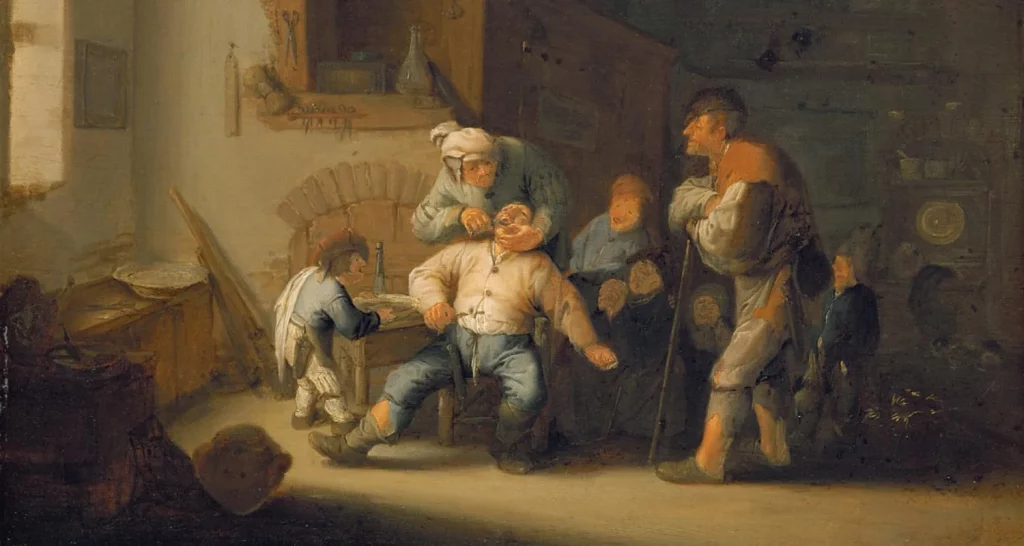
Dental care was primitive in the 1700s because there were no trained dentists and little knowledge about oral hygiene. M ost treatments were done by barbers using rough tools without pain relief.
Who took care of teeth in the 1700s?
In the 1700s, dentistry wasn’t its own profession. There were no dentists like we have today. Some dental work was done by physicians as part of general medicine, following practices from ancient times.
Most dental care was done by barbers or tooth pullers because they were good with tools and their hands, but they didn’t have any medical or dental training. They learned by practice and used basic tools to pull teeth.
- Their methods were often painful because there were no anesthetics.
- Tools were rough and unclean, and there were no antibiotics if infections occurred.
Because of this, people were afraid of dental treatments. Pain and serious risks were a normal part of life at the time.
Did people brush and floss their teeth in the 1700s?
People did practice basic tooth cleaning in the 1700s, but it was very different from modern brushing and flossing. They used simple tools like chew sticks or twigs to clean their teeth. Flossing, as we know it, didn’t exist until the early 1800s.
Most people didn’t know that brushing and flossing could protect teeth. Daily cleaning wasn’t common. Plaque and tartar built up quickly, leading to cavities, gum disease, and tooth loss at a young age.
How did diet make dental health worse?
People’s diets in the 1700s made their dental health worse. They ate a lot of bread, refined grains, and sugary foods.
- Most meals included bread as a main food. Wealthier people used sugar and molasses in drinks, cooking, and sweets.
- These foods stuck to teeth and fed bacteria. The bacteria produced acid that damaged enamel and caused cavities.
Because people didn’t clean their teeth daily, these sugars caused tooth decay, pain, infections, and tooth loss at a young age.
How did dentistry begin as a profession?
As we have seen, dentistry didn’t exist as a profession in the 1700s during the American Revolution. Most dental work was done by barbers or physicians with no special dental training.
A big change started in 1210 in France when the Guild of Barbers was created. This group marked the beginning of organized training for dental care.
Later, barbers split into two groups:
- trained surgeons, who did complex surgeries.
- lay barbers, who did haircuts, simple hygiene work, and tooth extractions.
This separation was an important first step. It led to more specialized and skilled dental practices and set the stage for dentistry to grow into a special profession in the future.
What dental practices and tools did people use in the 1700s?
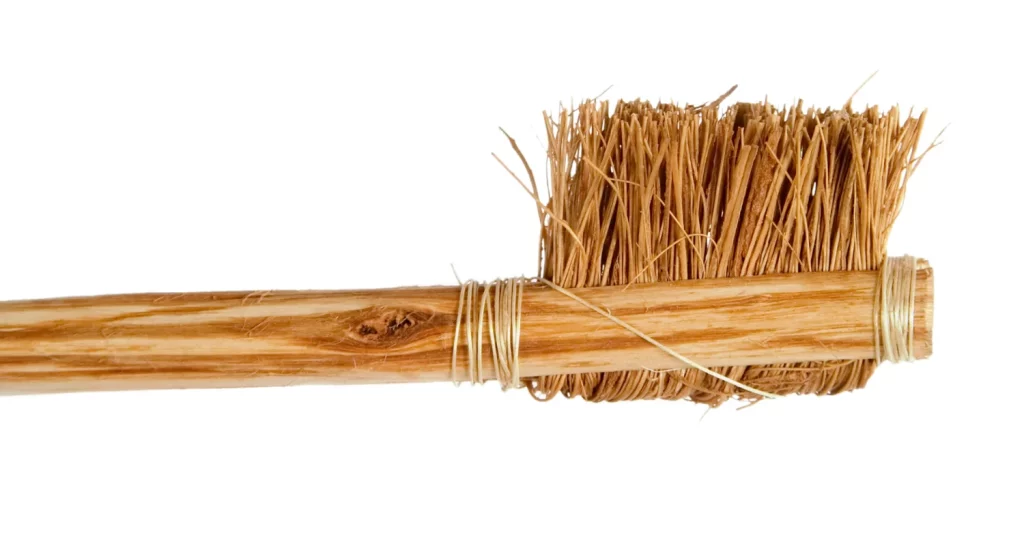
In the 1700s, people used twigs, early toothbrushes, and simple powders to clean their teeth, but these methods were rough and not very effective.
How did people clean their teeth?
Maintaining a healthy smile back then was very different from today. People didn’t have plastic toothbrushes or fluoride toothpaste. Instead, they used:
- Natural brushes: twigs from neem and miswak trees were common. People chewed the ends until they frayed and used them to scrub their teeth.
- Abrasive cleaners: salt and baking soda were used to clean teeth. These gave some friction to remove dirt, but they didn’t kill bacteria like modern toothpaste.
- Early toothbrushes: by the late 1700s, some wealthier people used toothbrushes with bone or wood handles and bristles made from animal hair. These brushes were rough and not as comfortable or effective as today’s toothbrushes.
Were these methods effective?
These cleaning practices were very basic compared to modern dental care.
- Effectiveness: natural brushes and abrasive cleaners were simply not as efficient at removing plaque and bacteria compared to modern toothbrushes and toothpaste.
- Gentleness: twigs and abrasive powders could be harsh on gums and teeth, whereas modern brushes and toothpaste are formulated to be gentle yet effective.
- Hygiene awareness: people didn’t know the importance of brushing and flossing regularly, so dental problems like cavities and gum disease were common.
Dental care in the 1700s was uncomfortable, rough, and not very effective. Today, we’re lucky to enjoy gentle, safe, and powerful dental tools to keep our teeth clean and healthy.
What were typical dental issues and treatments in the 1700s?
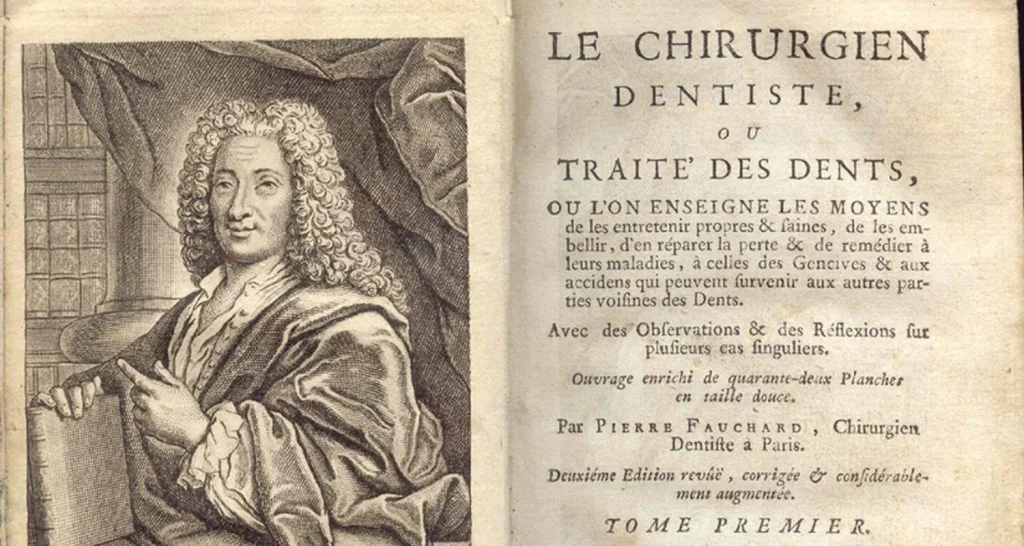
Tooth decay, gum disease, and abscesses were widespread. With no modern treatments, extractions were often the only solution, and they were painful and risky.
What dental problems did people have?
People often suffered from:
- cavities and tooth decay that were rampant from sugar-heavy diets.
- gum disease and abscesses that caused swelling and serious infections.
- severe toothaches
At that time, people didn’t understand the importance of keeping their natural teeth. When a tooth hurt, pulling it out was seen as the easiest solution, and extractions became a routine treatment. The experience was extremely painful and risky.
Were there any early dental innovations?
Yes. Although dental care was primitive, some advancements happened:
- 700 AD (China): Silver paste was used as an early dental amalgam.
- 1723 (France): A French surgeon published The Surgeon Dentist, a book covering oral surgery, dentures, and anatomy, becoming a cornerstone for modern dentistry.
- 1746: A Frenchman Mouton suggested using white enamel on gold crowns for a better appearance.
- 1790: Porcelain teeth were introduced for dental prosthetics, improving appearance and oral health.
How did people treat dental pain and tooth loss in the 1700s?
When facing a toothache or lost teeth, people relied on herbal remedies and very basic dentures, but these solutions were often uncomfortable and ineffective.
What remedies did people use?
- Clove oil was a go-to natural anesthetic. People applied it directly to sore teeth to numb the pain. The active compound in clove, eugenol was widely used in traditional dental care.
- Herbal mixes containing clove, star anise, cinnamon, myrrh, ginger, or mustard were used as makeshift mouthwashes to soothe gums and freshen breath.
These remedies provided only temporary relief and didn’t cure serious issues like abscesses or deep decay.
What dentures did people use?
- Early dentures in the 1700s were crafted from animal or human teeth, ivory (from hippos, elephants, or walruses), or human teeth, attached with springs or gold wire.
- Such dentures were often poorly fitting and heavy, leading to mouth sores and difficulty eating.
- Porcelain dentures began to emerge around 1770, offering a cosmetic improvement, but they were fragile and expensive.
In the 1700s, dental care for pain or lost teeth involved clove oil and herbs, offering only slight, temporary relief, along with primitive dentures made from natural materials that were uncomfortable and unstable.
What were early American dental practices like?
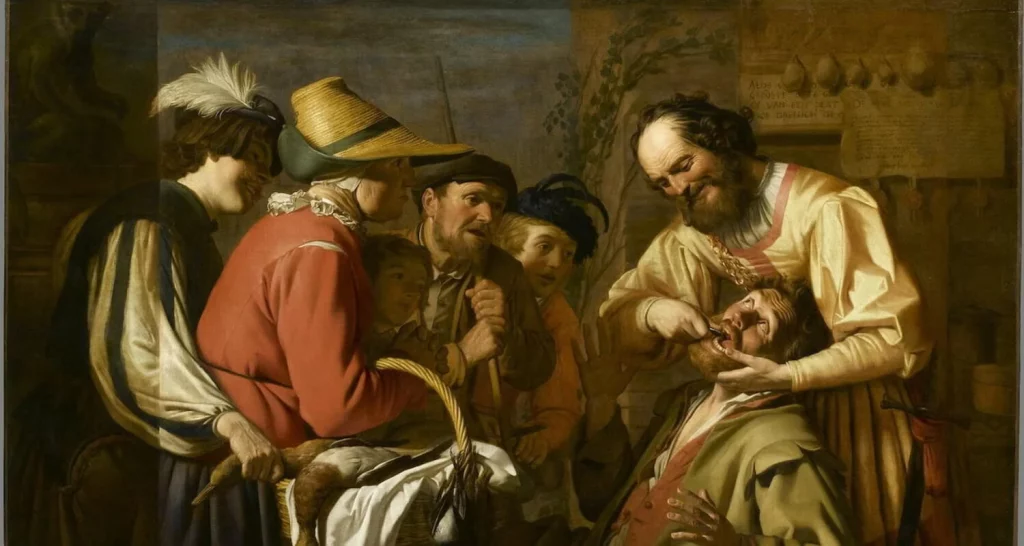
When the Pilgrims arrived in America in 1638, they brought:
- physicians
- an apothecary
- three barber-surgeons
Barber-surgeons did tooth extractions along with haircuts and bloodletting. Early dentists like Woofendale, Mills, Baker, Flagg, Greenwood, and Paul Revere improved dental care slightly, but their methods were still rough and painful.
How has dentistry changed since then?
In the 1700s, having a healthy smile was a luxury. Painful treatments, ineffective remedies, and uncomfortable dentures were common. Today, thanks to centuries of progress, we have safe, effective, and comfortable dental care that protects our teeth and health.
Who were the key figures in the rise of professional dentistry?

Modern dentistry emerged thanks to pioneers like Pierre Fauchard in France and early American dentists such as John Baker, Isaac and John Greenwood, and Paul Revere, who helped turn tooth care into a trusted profession.
Who was Pierre Fauchard?
Pierre Fauchard (1678–1761) is known as the father of modern dentistry. Before his work, dentistry was mostly done by barbers with no formal training.
In 1723, Fauchard published Le Chirurgien Dentiste (The Surgeon Dentist), which:
- explained oral anatomy and dental diseases.
- described how to remove decay and restore cavities.
- covered orthodontics, endodontics, and replacing missing teeth.
What was innovative about Fauchard’s work?
Fauchard didn’t just collect knowledge. He:
- criticized old, ineffective methods.
- debunked the idea of “tooth worms,” showing that sugar caused decay.
- promoted dentistry as a science-based profession, fighting against untrained charlatans.
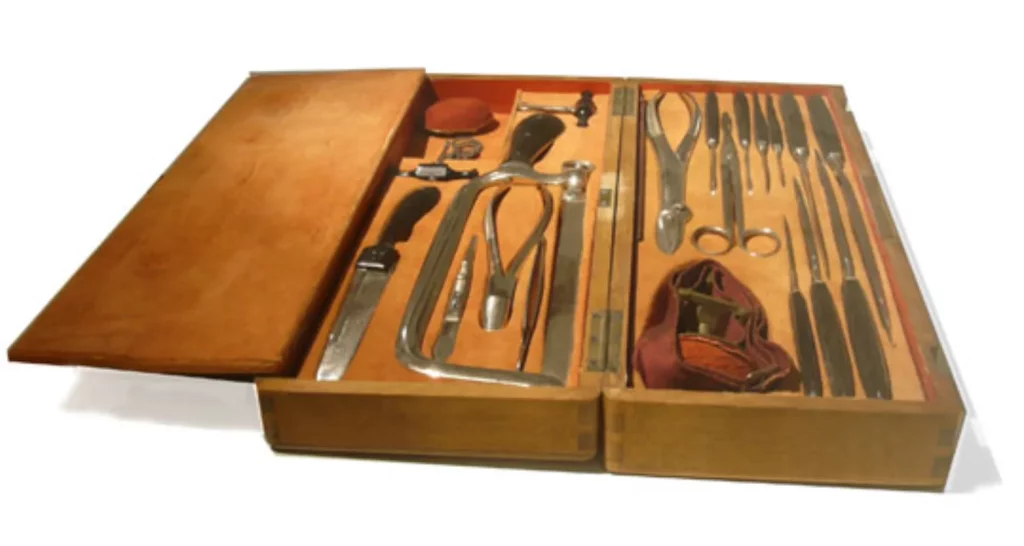
Who were the first dentists in America?
As European colonists moved to America, they brought dental knowledge with them. Early dental care was provided by barber-surgeons and tooth pullers, but professional dentistry grew with trained practitioners.
John Baker
- Arrived from England in 1760.
- Became the first medically trained dentist in America.
- Taught other early dentists.
Isaac and John Greenwood
- Isaac Greenwood was the first American-born dentist (1779).
- His son, John Greenwood, became George Washington’s dentist.
Contrary to myths about wooden teeth, Greenwood made Washington’s dentures from metal, bone, and ivory, with springs for function and aesthetics.
Paul Revere
Before his famous midnight ride, Paul Revere learned dentistry from John Baker. He:
- Made ivory dentures.
- Used dental work for early forensics, identifying a body by a dental appliance he had made.
How did dentistry become a recognized profession?
The foundations were laid in the 1630s, when barber-surgeons arrived with settlers in Massachusetts. Over time:
- Immigrant dentists like Robert Wooffendale and Jacques Gardette opened practices in New York and Philadelphia.
- Artisans, like ivory turners, transitioned into dentistry, bringing manual skill to dental prosthetics.
The work of these pioneers turned dentistry from rough tooth pulling into a skilled medical profession. They taught others, improved treatments, and set the stage for modern, science-based dental care.
Conclusion
Looking back at dental care in the 1700s shows us how far we’ve come. From painful tooth extractions by barbers to today’s safe, comfortable treatments, dentistry has been transformed completely thanks to science and dedicated professionals.
Next time you visit your dentist, remember that modern care is a privilege. Regular check-ups and cleanings are simple ways to keep your teeth healthy and avoid the pain people once had to endure.
Frequently Asked Questions
By the late 1700s, some wealthier people in Europe used early toothbrushes made from bone or wood handles with animal hair bristles. Most others used chew sticks or twigs to clean their teeth.
They didn’t have toothpaste like today. People used powders made from salt, baking soda, charcoal, or crushed herbs to clean their teeth.
Yes, children often lost teeth at a young age. They ate sugary foods and bread, didn’t brush daily, and had no fluoride protection, leading to severe cavities and early tooth loss, which affected their chewing and nutrition.
Most cavities were ignored until they caused severe pain. Few people could afford fillings and even those were basic, using lead, tin, or wax, which didn’t last long. When pain became unbearable, the tooth was pulled out.
No, barbers didn’t receive formal dental training. They learned by practice and used basic tools to pull out teeth. Dentistry wasn’t recognized as its own medical field until later, so barbers handled extractions as part of their services.
How did people clean their teeth during the American Revolution?
They used twigs, chew sticks, or basic powders like salt and baking soda to scrub their teeth.
Did George Washington really have wooden teeth?
No, his dentures were made from metal, ivory, animal teeth, and human teeth, but never wood.
Why did people lose so many teeth in the past?
Because they didn’t brush daily, ate sugary foods, and had no dental treatments to save decayed teeth.
References
- Connor, R. A. , Kamen, . Saul , Ring, . Malvin E. and Dorfman, . Jeffrey (2023, December 28). dentistry. Encyclopedia Britannica. https://www.britannica.com/science/dentistry
- Perry, D.A., Fales M.H. (Jan 14, 2015). Historical Perspectives on Dental Hygiene and Periodontology. Pocket Dentistry. https://pocketdentistry.com/1-historical-perspectives-on-dental-hygiene-and-periodontology/
- Kezian, Steven A. (2020) “The History of the Dental Profession – From Ancient Origins to Modern Day,” Pacific Journal of Health: Vol. 3: Iss. 1, Article 2. DOI: https://doi.org/10.56031/2576-215X.1006. https://scholarlycommons.pacific.edu/pjh/vol3/iss1/2
- Kenmore, F. (Sep 02, 2015). Dental Care in Early America. https://livesandlegaciesblog.org/2015/09/02/dental-care-in-early-america/
Contact Us
If you have any questions about using halitosis and how to treat it or other dental topics, you can contact us at Channel Islands Family Dental as well as our page on Facebook. We look forward to your visit and we will make a timely diagnosis. Our dentists in Oxnard, Santa Paula, Ventura, Newbury Park, and Port Hueneme will be able to guide you toward the best treatment to take care of your health and give you back your best smile.



